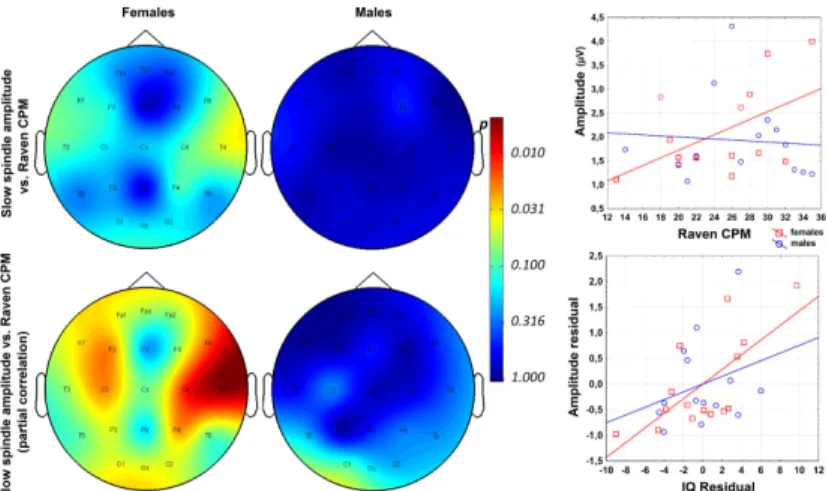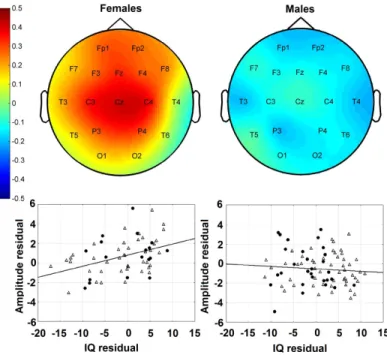Individual Characteristics of the Sleep Electroencephalogram as Markers of Intelligence– Effects in a Broad Age and Intelligence
Range
Doctoral thesis
Péter Przemyslaw Ujma Semmelweis University
Doctoral School of Mental Health Sciences
Advisor: Róbert Bódizs, Ph.D., chief research fellow
Official Reviewers: Dr. Gábor Csukly, Ph.D., lecturer
Kristóf Kovács, Ph.D., chief research fellow
President of the Qualification Committee: István Bitter, MD, DSc, professor Members of the Qualification Committee: Pál Czobor, MD, Ph.D., associate
professor
Dezső Németh, Ph.D., associate professor
Budapest 2015
INTRODUCTION
Performance on standardized intelligence tests correlates not only with cognitive performance, but also with life history variables including school performance, social status, income, the prevalence of leading causes of death and the number of biological children. Because of its epidemiological and sociological importance the biological mechanisms of psychometric intelligence can be considered an important target for research.
The biological mechanisms of intelligence are not fully clarified yet. Some of the correlates of intelligence – such as the volume and hemodynamic responses of certain brain areas, glucose consumption during rest and cognitive strain and waking EEG parameters – are often characterized by a sexual dimorphism, that is, correlates of intelligence were different in males and females.
Due to its individual stability and genetic determination spectral characteristics of the sleep EEG are strong potential indexes of individual differences in cognitive and other abilities. Previous research has revealed that certain parameters of sleep spindles, which are NREM sleep features generated in thalamocortical and reticular thalamic networks, may be related to intelligence. However, most studies had a low sample size, their methodology and results were not unequivocal, and no study investigated the possibility of a sexual dimorphism.
AIMS
In our study we aimed to investigate the relationship between sleep spindling and intelligence. We paid particular attention to avoid the methodological problems seen in previous studies, that is:
1.) we aimed to create a sample of a greater size than previous studies 2.) we detected slow and fast sleep spindles separately, and we considered individual differences in sleep spindle frequency
3.) in line with previous results about the biological correlates of intelligence we specifically investigated the possibility of a sexual dimorphism.
In order to further clarify our findings we repeated the study in a sample of 4-8 year old children, adolescents and adults, and in the adult sample we also included people of superior intelligence.
METHODS
We investigated the relationship between sleep spindling and intelligence in 213 subjects, including 29 children (age: 4-8 years, 15 girls), 24
adolescents (age: 15-22 years, 12 girls) and 160 adults (age: 17-69 years, 72 females). All participants gave informed consent (including parental approval when necessary). The studies were approved by the ethical committees of Semmelweis University and the Max Planck Institute. All subjects underwent all-night polysomnography recording, and on a separate occasion filled out a version of the Raven intelligence test. We used the Coloured Progressive Matrices (CPM) in case of children, the Standard Progressive Matrices (SPM) in case of adolescents, and the Advanced Progressive Matrices (APM) in case of adults. Data collection of the adult sample was performed with the participation of the Max Planck Institute of Munich.
After sleep staging and artifact removal from polysomnography recordings, sleep spindles were detected using the IAM method. This method
determines individual slow spindle frequencies based on the NREM sleep EEG spectrum of frontal electrodes and fast spindle frequencies based on the NREM sleep EEG spectrum of central and parietal electrodes,
considering visible spectral peaks. Detection of sleep spindles takes place after filtering the EEG signal to the individual sleep spindle frequencies.
Threshold amplitudes are determined individually for each electrode based on the parameters of the spectral peak. Therefore, IAM is able to separate slow and fast spindles and detect them using empirically determined but individual parameters.
We calculated Pearson correlation coefficients between Raven test results and average sleep spindle parameters (individual frequency, density, duration and amplitude). In case of children and adolescents, partial correlations were also computed. Correction of multiple testing was performed by the Rüger area method in children and adolescents, yielding areas of significance, while in case of adults we used the Benjamini- Hochberg method of false discovery rate correction with a better spatial resolution.
RESULTS
In case of male children fast spindle density was a maturational marker (in correlated with intelligence, but this effect was entirely explained by the effects of age). In female children, the amplitude of temporal slow spindles was a trait marker of intelligence (it mainly correlated with intelligence after correcting for the effects of age).
Figure 1. Normal (upper panels) and age-corrected partial (lower panels) correlation between slow spindle amplitude and Raven CPM score in 4-8 year old female (left side) and male (right side) children. Topographic plots
illustrate the distribution of the p-values of correlation coefficients on the scalp. The lower scatterplot shows the residuals of slow spindle amplitude on T4 and Raven CPM score, after regressing for the effects of age in order
to reliably illustrate the partial correlation.
In case of adolescent males fast spindle frequency correlated positively with intelligence. In case of adolescent females fast spindle density and amplitude also positively correlated with intelligence, but the correlation with amplitude was partially explained by the effects of age.
Figure 2. Correlation between Raven SPM IQ in adolescent females (left topographic plot) and males (right topographic plot). Topographic plots represent the distribution of the p-values of correlation coefficients on the
scalp. The scatterplot shows the relationship between fast spindle amplitude on C3 and Raven SPM IQ.
In case of male adults the density of occipital fast spindles correlated negatively with intelligence. In female adults, the duration of slow spindles and the amplitude of fast spindles correlated positively with intelligence.
Figure 3. Partial correlation between fast spindle amplitude and Raven APM scores in adult females (left side) and males (right side). Topographic plots
illustrate the distribution of correlation coefficients on the scalp.
Scatterplots illustrate fast spindle amplitude on Cz and Raven APM scores after regressing for the effects of age in order to reliably illustrate the partial
correlation. Triangles represent subjects recorded in Munich, and circles represent subjects recorded in Budapest.
DISCUSSION
Our results confirmed that individual parameters of sleep spindling
correlate with intelligence. The most consistently found index of intelligence was sleep spindle amplitude. However, this relationship was only found in females, that is, the relationship between sleep spindling and intelligence is sexually dimorphic, not unlike other biological correlates of intelligence.
Since this correlation was consistently found in case of children, adolescents and adults, it is probably not the result of pubertal maturation or childhood socialization. Other spindle parameters only correlated with intelligence either weakly or not consistently across samples.
Previous research has revealed that sleep spindle amplitude relies on the structural parameters of white matter tracts comprising thalamocortical networks. White matter volume and connectivity is usually greater in females, and some studies found a sexually dimorphic relationship between intelligence and grey or white matter structure. Typically, the involvement of white matter in intelligence was more prominent in females.
Based on these results we hypothesize that the correlation between sleep spindle amplitude and intelligence, which was only seen in females, reflects the strength of white matter connections in the thalamocortical networks, and it ultimately suggests that increased connectivity between distant cerebral areas is a mechanism behind intelligence which is more prominently seen in females. In order to test this hypothesis, we plan to collect further data including both polysomnography and structural imaging in order to test the supposedly female-only triangular relationship between sleep spindle amplitude, the strength of white matter connections and intelligence.
PUBLICATIONS
Publications related to the thesis:
Péter P. Ujma, Boris Konrad, Lisa Genzel, Annabell Bleifuss, Péter Simor, Adrián Pótári, János Körmendi, Ferenc Gombos, Axel Steiger, Róbert Bódizs, Martin Dresler (2014). Sleep spindles and intelligence: Evidence for a sexual dimorphism. The Journal of Neuroscience, 34(49):16358-68. IF: 6.344
Róbert Bódizs, Ferenc Gombos, Péter P. Ujma, Ilona Kovács (2014). Sleep spindling and fluid intelligence across adolescent development: sex matters.
Frontiers in Human Neuroscience, 8:952. IF: 2.986
Péter P. Ujma, Ferenc Gombos, Lisa Genzel, Boris Nikolai Konrad, Péter Simor, Axel Steiger, Martin Dresler, Róbert Bódizs (2015). A comparison of two sleep spindle detection methods based on all night averages:
individually adjusted versus fixed frequencies. Frontiers in Human Neuroscience, 9:52. IF: 2.986
Péter P. Ujma, Piroska Sándor, Sára Szakadát, Ferenc Gombos, Róbert Bódizs (submitted). Sleep spindles and intelligence in early childhood – developmental and trait-dependent aspects.
Publications not related to the thesis:
Péter Simor, Klára Horváth, Péter P. Ujma, Róbert Bódizs (2013). Increased alpha power indicates wake-like EEG oscillations during different sleep stages in nightmare disorder. Biological Psychology 94:592-600. IF: 3.743
Péter Simor, János Körmendi, Klára Horváth, Ferenc Gombos, Péter P. Ujma, Róbert Bódizs (2014). Electroencephalographic and Autonomic Alterations in Nightmare Disorder during Pre-and Post-REM periods. Brain and Cognition 91C:62-70. IF: 2.477
Péter P. Ujma, Péter Simor, Ferri Raffaele, Dániel Fabó, Anna Kelemen, Loránd Erőss, Róbert Bódizs, Péter Halász (2015). Increased interictal spike activity associated with transient slow wave trains during non-rapid eye movement sleep. Sleep and Biological Rhythms. 13: 155–162. IF: 0.588


